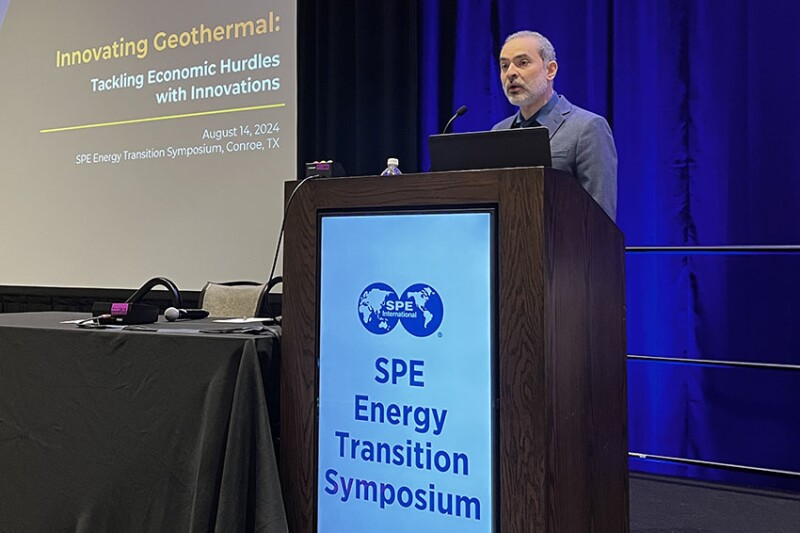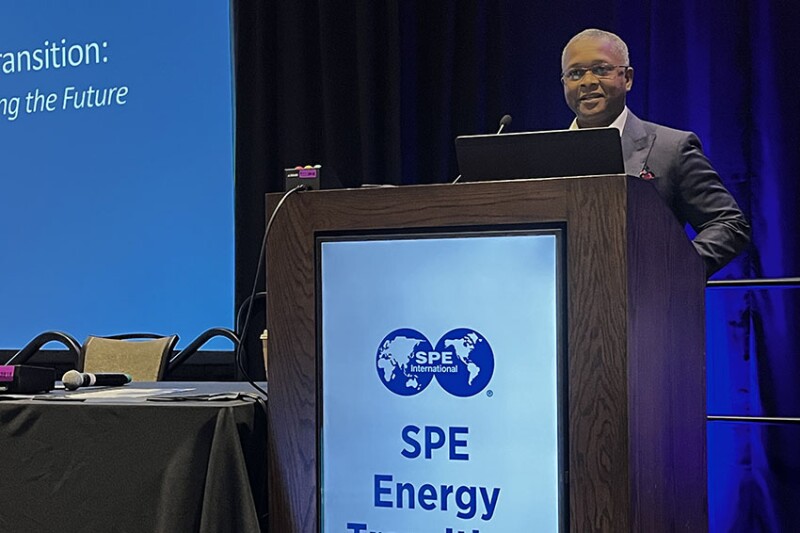Costs, funding, and permitting remain top challenges for energy transition projects, particularly in the geothermal and carbon capture and sequestration (CCS) spaces.
Speaking during SPE’s Energy Transition Symposium 12–14 August, Sage Geosystems CEO Cindy Taff said the industry must drive down the cost of next-generation geothermal so that it’s commercially viable and cost-competitive with other forms of energy.
“People want clean energy, but they don't want to pay a lot of money for it,” she said. “You still have to be cost effective.”
Part of driving costs down, she said, is through scale.
Obtaining funding is part of scaling new technology, and that’s not always easy, as Sarah Jewett, vice president of strategy for Fervo Energy, said.
“We’ve been told the No. 1 rule of geothermal project finance is ‘Don’t do it,’” she said.
Since its inception, Fervo has rolled out a pilot project in Nevada and is progressing a 400 MW project in Beaver County, Utah.
Even though “we thought we’d done a first-of-a-kind” in Nevada with the 3.5 MW Project Red, she said, the second project’s different geography meant it was still treated as a first-of-a-kind. Raising capital for the next project was tricky.
But that’s not the only challenge. The supply chain for some geothermal equipment is somewhat limited. While it’s possible to “pull PDC (polycrystalline diamond compact) bits off the shelf” for drilling, acquiring the nine full-scale turbines needed by 2026 for the current project left a limited choice, she said.
Of the four suppliers in the market, one was a competitor, one had never built a turbine larger than 2 MW, and one offered a bid more than quadruple the cost of the other bids.
“That left one supplier for our biggest project, and they had never built nine at once,” she said. “We need a lot more people in the OEM (original equipment manufacturing) space.”
Teverra CEO Hamed Soroush said many of the technologies intended for the energy transition face multiple challenges to achieving widespread deployment, such as evolving markets, a lack of technology standards, and gaps in knowledge.

While geothermal technology is a viable option for the energy transition, he said, harnessing the earth’s heat today is not necessarily viable for a range of reasons. Some locations have harvestable heat close to the surface while in other regions it’s necessary to drill deep to access the hot rocks, which is not economically viable, he said.
“Geothermal is renewable and abundant, right? Is it accessible or not? Not today,” he said.
Soroush said geothermal is reliable and renewable, with the heat “always there. It's not going anywhere.” A benefit to geothermal energy is that it can provide base load energy, something that renewable sources like wind and solar can’t provide.
“For this reason, geothermal has been considered one of the most resilient, basically renewable energy choices, which is a big advantage,” he said.
While wind and solar have gained a lot of traction since 2000, geothermal has not grown proportionally to its potential, Soroush said.
Part of the reason is due to policy and permitting. Permitting can be time-consuming, making projects less attractive for investors. Government support of the technology does the opposite, he said.
“If you ask me which countries will be successful in geothermal, I would say, look at the government, how much support geothermal is getting from the government. That shows how basically successful geothermal will be,” Soroush said.
The US, for instance, is now demonstrating its support of the technology through grants.
“Government plays the major role, actually, because investors follow government. When government puts money somewhere, investors basically trust and just follow,” he said.
Encouraging Clean Energy, CCS
Lindsay Cooper Phillips, senior Gulf Coast regional manager for the Clean Air Task Force, said cost and permitting remain as major barriers to scalability for clean energy projects.
“Cost parity is crucial for industries to choose clean energy over traditional energy, and we see many industries that are demanding clean power,” she said. “They're demanding and announcing clean energy projects left and right, very exciting, but until we have this cost competitiveness between traditional and clean energy resources, it will be really hard to see scalability of clean energy.”
Vello Kuuskraa, president of Advanced Resources International, said permitting can be tough for CCS projects.
“I hope that becomes more streamlined over time,” he said.
Putting together the Class VI application for CO2 storage in a reservoir requires demonstration of safety measures, adherence to best practices, monitoring systems, and mitigation and remediation plans, he said.
“It can be a safe site if you do it right,” Kuuskraa said.
Over the years, he noted, the oil and gas industry has learned a lot about CO2 injection through its enhanced oil recovery (EOR) efforts.
Beyond permitting, he said there is a concern over whether tax credits that extend 12 years will cover costs for storage of CO2 for 3 or more decades.
“There needs to be a business case,” Kuuskraa said, adding it is hoped the costs of operating the storage system would be paid for within the tax break’s timeframe.
Nathan Ellebracht, a researcher at the Lawrence Livermore National Lab, said more than half of land area in the US has potential for geologic storage of CO2.
“You might say the United States is the Saudi Arabia of pore space,” he said.
Linal Perera, project development manager at Svante, which makes filters for source point capture and direct air capture, said the CCS industry is still developing.
“There's no roadmap. There's no defined, ‘hey, this is how you do it, and how you do it right, and avoid a bunch of headaches.’ And there are a few companies that actually want to venture into the unknown,” he said.
Finding a Roadmap

Eric Powell, director and senior partner at Partners in Performance, said many breakthrough technologies that could help with emission reduction are not ready yet for deployment.
“There's a transition that has to happen, but this is where the opportunity roadmap” goes, he said.
Existing measures include activities like gas reinjection and properly abandoning wells while other technologies will be optimized in the short term, such as waste heat recovery and leak detection, he said. Between 2030 and 2050, process upgrades will help with efficiency, low-carbon fuels will begin to serve as substitutes in the energy mix, energy generation technology will improve electrification, and CO2 storage, carbon capture, and more will help with fugitive emissions capture.
But before pursuing a specific technology or policy, Powell said, it’s important to consider questions around the purpose.
“Are we trying to reduce emissions or kill fossil (fuels)? They're not one and the same,” he said. “We can reduce emissions and keep fossil (fuels).”
He also noted a tendency to offer “diametrically opposed choices” that pit people against each other.
“That’s friction that’s unneeded,” he said.
Powell urged the industry to avoid making energy transition efforts into a religion while remaining open to pursuing a different effort if a current effort is not optimal.
“We have to get the basics right,” he said.
A Matter of Language
Med Kamal, Chevron emeritus fellow and SPE 2023 President, noted demand for all forms of energy will continue to increase through 2050, based on data from the US Energy Information Administration, the International Energy Outlook 2023, and Energy Institute Statistical Review of Global Energy 2023. In 2022, total energy demand was 638 quadrillion BTUs, and that number grows to 855 quadrillion BTUs by 2050.
“I’m not fond of the term energy transition,” he said. “It doesn’t describe what we are doing.”
Energy transition is a limiting term, and because many different forms of energy will contribute to the future mix, he said he prefers the term energy expansion.
While the energy future is lower carbon, he said, hydrocarbon demand will remain resilient through the cycles.
Fueling the Future Workforce

One of the largest challenges the industry faces is the public’s perception of it, and the role it will play in the future of energy, Molly Determan, CEO of Energy Workforce & Technology Council, said.
It is hard, too, to recruit people with expertise in different skills when they hear from the current administration that the oil and gas industry’s future has a limited lifespan, she said.
“When we're going out and trying to recruit people with these new skill sets, whether it's in automation or data analytics and all of that, those are people that might not have been in our industry before, and bringing them into what they might perceive as an industry that is going to be gone in 10 years, that’s a challenge,” she said.
The industry needs to reframe what it is and the role it will play in the energy mix of the future, Determan said.
And as the energy industry evolves, it will still need welders, electricians, and engineers, she said.
“Some of those roles are going to change” because of advances in technologies like automation, she said. For example, a welder job may evolve from actually welding to checking welds done by an automatic welding machine.
Bryant Black, regional director of workforce development at the Greater Houston Partnership, said the industry will not necessarily evolve the way the public thinks it will change.
“People think we’re going to go from the Flintstones to the Jetsons, but that’s not what’s happening,” he said.
As such, many of the support skills needed in the industry will continue to be needed, such as logistics, information technology, customer service, sales, and compliance to name a few.
Rob Wingo, EQT’s executive vice president of midstream, said that 3 years ago when EQT started its new ventures team which is dedicated to helping solve challenges the world is facing by using technology, he was worried about finding people able to work in that area.
Those concerns, he said, were unfounded.
“It’s easy to find people that want to do this,” he said.
While some with the knowledge needed for the projects—such as developing infrastructure that can produce and transmit clean energy—are already employed or building teams of their own, he said, it’s not difficult to “tweak” the skill sets people already have. As a bonus, he added, the learning curve is generally not steep.
“Six months, and they have the basic fundamentals,” he said.
The company’s focus on the energy transition is also helping with recruiting, Wingo said.
“If we as a company were not focusing on this, I think it would be extremely hard to recruit,” he said.
Doug Conquest, vice president of sequestration project development for 1PointFive, said finding people is the one aspect of the energy transition he “feels most relaxed about.” One reason, he said, is that the longevity of the transition to a low-carbon future allows new graduates to “see a pathway all the way through their career.”
David Reid, chief technology officer at NOV, said one of the biggest challenges NOV faces in recruiting personnel is for high-demand jobs like robotics engineering and data science. But, he said, a winning company culture encourages retention of those skills.


